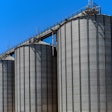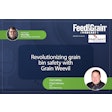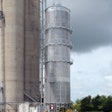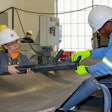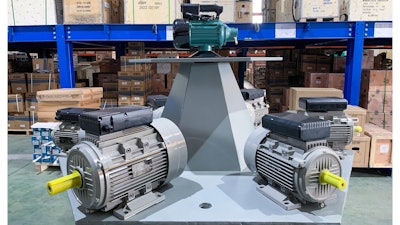
Grain handlers know that motor selection can make or break facility operations. The wrong motor choice leads to frequent breakdowns, excessive energy bills and production bottlenecks that cost thousands of dollars during peak harvest seasons.
Every grain handling operation faces the same challenge: finding motors that survive dust, moisture and temperature extremes while maintaining consistent performance when loads vary from empty belts to maximum capacity runs. Grain prices fluctuate and energy costs climb, making the right motor technology essential for staying competitive and keeping equipment running year after year.
During an episode of Feed & Grain Podcast Randall Sorrells, global segment sales manager for food and beverage at ABB explained, "With the VFD you can now start controlling your process rather than your process so much controlling you," "We're looking at process controlled, but now we're actually starting to really look at process efficiency as well."
Grain and feed facility managers who follow proven motor selection methods address common operational challenges while improving their bottom line. Control system integration and energy optimization strategies have delivered measurable results across different types of grain handling operations.
Role of smart motors in grain handling automation
Smart motors have become the foundation of modern grain handling facilities. These motors do more than power conveyors and augers — they communicate with facility control systems to optimize operations automatically.
Smart motors connect directly to Programmable Logic Controllers (PLCs) and Supervisory Control and Data Acquisition (SCADA) systems using industrial communication protocols like Modbus, Profinet or EtherNet/IP. This connection allows grain handlers to control multiple motors from a single interface, automate equipment startup and shutdown sequences, and make real-time adjustments based on grain flow rates.
Built-in sensors continuously monitor critical parameters including current draw, operating temperature, vibration levels, and speed variations under different load conditions. This real-time data helps grain handlers identify potential problems before equipment fails.
"We offer what's called a motor sensor, the smart sensor… it's a health monitor that sits directly on the motor that's gathering information, start, stops, vibration, RPM, speed variations," says Sorrells. "Think of that as like a wrist worn health monitor… but we offer an additional service that's utilizing that data that kind of steps it up to an EKG because then we have doctors behind the scenes reading the charts."
Smart motors support proactive maintenance strategies that help grain handling facilities avoid costly emergency repairs. "What we're wanting to do is be able to detect it well before a failure and do predictive maintenance," Sorrells notes. "That's where you can't see it, you can't really feel it with human touch, that's why these sensors become so valuable in that predictive maintenance side of things. Unclaimed downtime is very costly."
Smart motor technologies for grain handling applications
Three specific technologies deliver the biggest impact for grain elevator and feed mill operations:
Premium efficiency motors classified as IE4 (Super Premium) and IE5 (Ultra Premium) cut energy costs compared to standard models. These motors use enhanced magnetic circuits, advanced rotor construction and higher-grade copper windings to reduce electrical losses.
"We're basically addressing a regulation that's not going to go into effect until June of 2027. It affects the horsepower ratings from 100 to 250 horsepower and it's going to require those motors to operate at an IE4 efficiency rating," explains Brandon Canclini, global product manager for definite purpose products at ABB.
Integrated motor-drive packages combine the motor and variable frequency drive (VFD) into a single unit, eliminating separate control cabinets. This design works well for grain handling operations because dust-proof enclosures protect sensitive electronics from grain particles.
"We've been in the process of releasing a series of products which is called our Integrated Motor Drive. This is motors with VFDs directly coupled and attached to those motors," Sorrells says. "It is literally the most efficient package on the market that you can have right now."
These units automatically adjust motor speed based on material flow rates, preventing energy waste during partial loading. Built-in soft start capabilities also reduce mechanical stress on belts and chains during startup.
Sensorless vector control provides precise torque management without additional feedback devices. The technology creates a mathematical model of the motor within the drive, allowing for instantaneous torque response when augers encounter resistance.
"For anything that's like for the grain industry, you get into explosion applications," Sorrells notes. "By default in our standard product, we have that certification built into that product. So it's bolt in replacement but it's good for VFDs and non-VFDs and being able to also take care of those explosion-proof applications."
Energy optimization and cost reduction strategies
The choice between soft starters and variable frequency drives affects both energy bills and equipment life. Soft starters reduce the electrical surge when motors kick on, while VFDs deliver better energy savings through speed control, cutting overall consumption by 10-50%.
Motors running at partial loads create reactive power demands that show up as penalty charges on utility bills. Power factor correction capacitors at motor control centers boost power factor from typical 0.7-0.8 values to 0.95 or higher, cutting overall electrical costs by 5-8%.
"Every single one of our customers, all the end users, they're running money machines. They're stamping out $100 bills and so it's very important to keep those money machines running," Sorrells emphasizes. "Any downtime that you can prevent — you may have to pay a nickel more for this or that but if it can prevent that downtime, what's it worth at that point?"
The most successful grain handling operations balance multiple factors when selecting motor technologies. They match efficiency ratings to specific applications, evaluate starting torque requirements based on actual load conditions, and ensure compatibility with existing automation systems.
"We made it to where it's a drop-in replacement," Canclini says of their new IE4 motors. "It follows the NEMA frames and we offer it in standard mounting as well as the C-FACE mounting. So it's going to be really easy to find a similar product that meets application requirements… pull the old motor out and drop the new motor in and boom, they've got their starting savings."
Premium efficiency motors and advanced control systems require higher upfront investment, but payback periods typically range from 9-24 months depending on usage patterns.
The path forward
Smart motor selection represents a shift from viewing motors as basic power components to recognizing them as intelligent system elements. Grain handling facilities benefit from this technology through reduced operating costs, extended equipment life and improved throughput reliability.
"What we're constantly pushing the envelope on is reliability," says Sorrells. "You can get a cheaper widget out there, but if you're having to replace it on very regular interval, especially if you have any social conscience as far as carbon footprint… it takes a lot of energy and a lot of resources to first make any motor."
The methods outlined in this article provide a practical roadmap for implementing these technologies. Start with high-use equipment where smart motors will deliver maximum impact, then expand the system as capital allows and operational experience grows.
.jpg?auto=format%2Ccompress&crop=faces&fit=crop&h=48&q=70&w=48)










